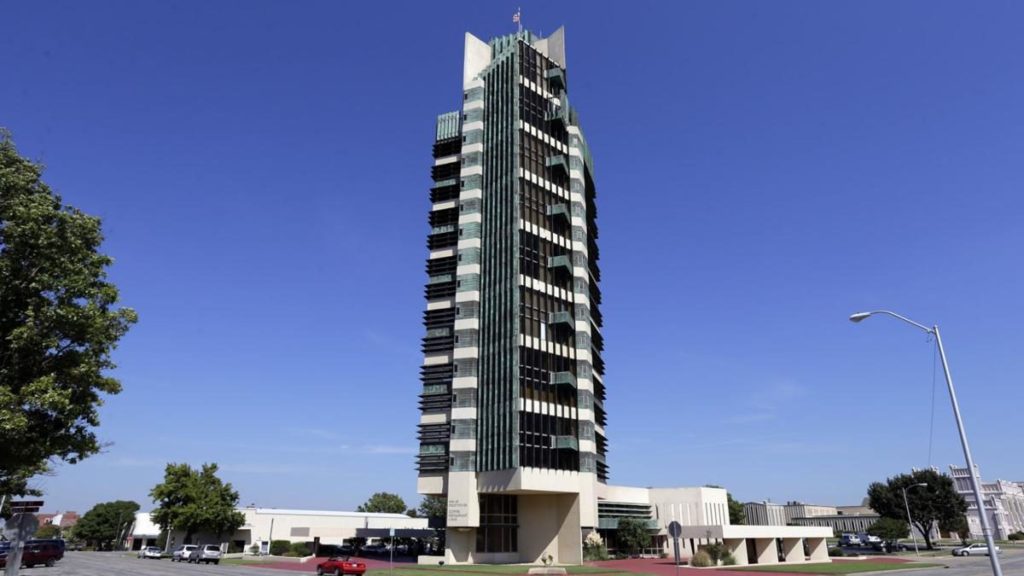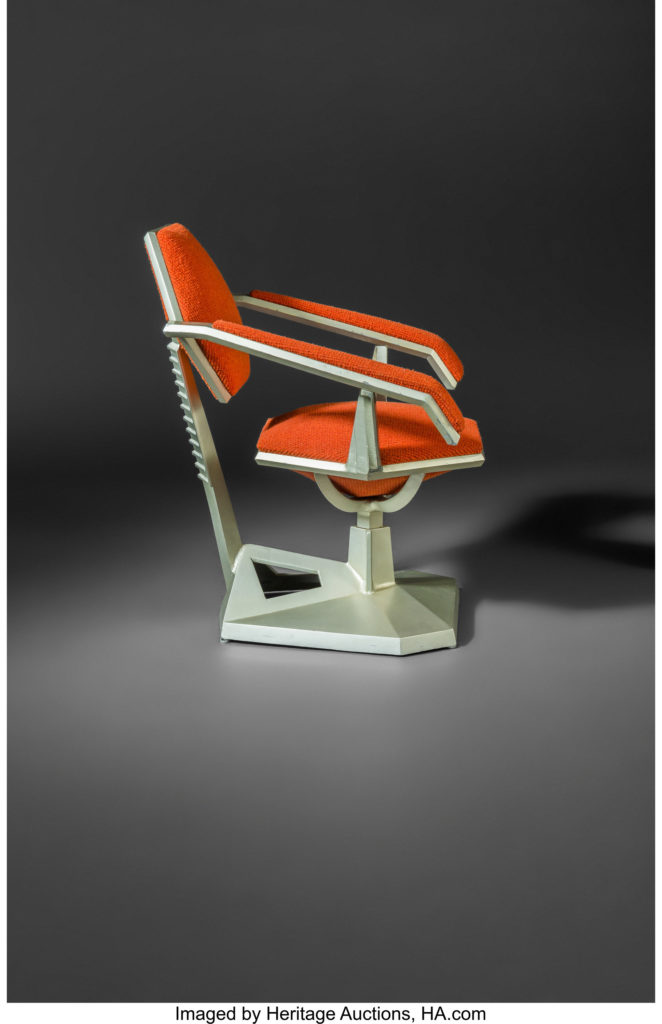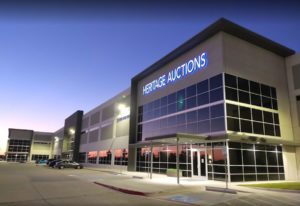
From a casual armchair to tables and relief panels, more than a dozen pieces of furniture designed by Frank Lloyd Wright for the Price Tower are for sale at auction on October 1, 2019 by Heritage Auctions. Auction also includes architectural models and drawings by Dennis Oppenheim.
Preview Frank Lloyd Wright and other works in the October 1st design auction.
Auction Preview in Dallas September 26-30, 2019 at Heritage Auctions – Design District Showroom. 1518 Slocum Street, Dallas, TX 75207. Live Signature® Floor Auction is 11:00 AM Central Time, Tuesday, October 1, 2019.
Frank Lloyd Wright in the 2019 October 1 Design Signature Auction – Dallas #5420
Price Tower, Frank Lloyd Wright’s only realized skyscraper, built in Bartlesville Oklahoma in 1956, remains a fascinating and complex part of his legacy. It is at once a striking example of modern design, as well as an homage to the prairie days of his youth. His meticulous attention to each detail, no matter how small, from designing the building itself as well as the furniture and decor contained within, resulted in a Gesamtkunstwerk at a scale seldom seen.

Casual Armchair from Price Tower, Bartlesville, Oklahoma, 1956 By Frank Lloyd Wright (American, 1867-1959)
- Cast aluminum, fabric and paint
- 33 x 24-1/2 x 29 inches (83.8 x 62.2 x 73.7 cm)
- PROPERTY FROM THE COLLECTION OF PRICE TOWER ARTS CENTER, BARTLESVILLE, OKLAHOMA
- Estimate: $12,000 – $18,000.
Price Tower’s ‘Casual Chair’ otherwise known as the Sloped Armchair, was created for various spaces in the building, including H.C. Price’s executive office. Some forty were originally specified. The present example features the original silvered painted aluminum frame and Wright’s signature ‘red’ upholstery.
Harold C. Price, Sr.’s legacy began in Bartlesville, Oklahoma, where he moved after graduating from the Colorado School of Mines in 1912. At the turn of the 20th Century, business in Bartlesville boomed upon discovery of vast and lucrative oil fields, with energy giants such as Getty and Phillips Petroleum (and 150 other oil companies) planting roots in the town. Price began as a chemist for a zinc smelting company, but once that venture failed, he and his brother, Joseph M. Price, found their fortune first by pioneering a unique form of welding, and later branched out into building oil and gas pipelines. Price, Sr. was a progressive and innovative man — the embodiment of America’s trailblazing self-conception. Once his business outgrew their facilities, he sought to commission a new office space from an architect who shared his forward-thinking vision. In this way, he and Frank Lloyd Wright, the architect he would eventually hire, were kindred spirits. His first choice was Bruce Goff, a maverick architect and professor at the University of Oklahoma where Price’s two sons, Harold, Jr. and Joe, were both students. Joe Price asked Goff to design the structure and although Goff expressed interest, he suggested that Frank Lloyd Wright would be a better choice. Shortly thereafter, Joe Price met Wright at a university lecture and subsequently implored his father to inquire about a commission. Originally, Price had envisioned a modest building of three or four stories to house the daily operations of the H.C. Price Company, but was swept away by Wright’s grand proposal for a 19-story skyscraper in the middle of the Oklahoma prairie and agreed to the historic undertaking. In fact, Wright made such an impression on the family he was hired to build two other structures after the success of Price Tower: a home in Phoenix, Arizona for Harold Price, Sr., and a home in Bartlesville, Oklahoma for Harold Price, Jr.
Price Tower was used by H.C. Price Co. from its grand opening in 1956 until 1981 when the company relocated to Dallas, Texas. It was then that Phillips Petroleum took over ownership of the building and utilized its office space, and in 1990 began allowing the Bartlesville Museum and Sculpture Garden, later renamed the Price Tower Arts Center, to present exhibitions in the tower as well. Toward the end of the decade, Phillips restored and rehabilitated Price Tower, bringing it up to contemporary building codes and correcting the alterations that had been made throughout the years. Upon completion, Phillips Petroleum donated the building to the Price Tower Arts Center, which currently owns and operates the building. It now houses a hotel, restaurant, bar, and art galleries, with tours conducted daily.
Frank Lloyd Wright always had a complicated relationship to skyscrapers. At the start of his career, he worked for Adler & Sullivan, the iconic Chicago architecture firm responsible for the first steel-framed skyscraper, and over the course of his career designed numerous tall buildings. However, connection and conversation with nature was a central theme present in all of his designs, and he often found skyscrapers to be antithetical to this cause. They were large and looming, blocking natural light with their shadows, and they were responsible for congestion in cities. A midwesterner at heart, Wright believed in wide open space and the ability to spread out. He was especially antagonistic toward the popular post-war International Style architectural boom with its rational lines and lack of ornamentation, and took particular issue with Mies van der Rohe’s belief that a building should be a “machine for living.” Wright believed that machines should be regarded as the tools an artist utilizes in order to achieve something greater, arguing that a machine “cannot inspire or recreate humanity.” Any building meant for human use should retain its connection to the spiritual and the organic. In all that Wright designed, he sought to invoke the drama inherent to the natural world, where the building is no more a machine than an anthill.
For Price Tower, Wright borrowed heavily from a residential building he had drafted in 1929 for St. Marks-in-the-Bouwerie Church in New York City. Eschewing traditional rectangular framing, Price Tower and the earlier St. Marks design both feature a cantilevered system where a central column rises up from the foundation and the floors extend outward from that column, like branches extending from a tree. Wright referred to Price Tower as “the tree that escaped the crowded forest” because the skyscraper would stand alone in an uncluttered skyline, unlike the St. Marks plan which would be crammed in among other tall buildings. There is a complex system of repeated, rotated square forms that “pinwheel” out from the column, resulting in a building with no obvious primary facade. Each side of Price Tower is different, and each angle at which it is viewed reveals a new form, imploring onlookers to walk its perimeter in order to take in its total visage. Of course this was Wright’s intention — to highlight the unique beauty of a skyscraper detangled from the condensed masses of the metropolitan — a lone tree on the prairie. To emphasize the arboreal symbolism, Wright clad the exterior with copper panels and louvers, chemically processed to achieve a rich green patina, giving the impression of leaves swept up in a breeze. Although he was not working within the parameters of canonical mid-century modern design, he created a truly modern building, pioneering fabrication and engineering practices, and weaving them seamlessly with extant and traditional materials, resulting in a building that is reverential to its past while looking towards the future.
In this impressive undertaking, Wright created a singular holistic vision of Price Tower inside and out, personally designing practically every detail of the structure, transforming oft-overlooked elements such as a parking garage’s support beams or the handrail in a stairwell, from mundane necessities to intriguing features waiting to be discovered. Of course, the furniture was no exception. Wright designed custom built-in furniture as well as modular, movable furniture to allow for some customization of the space in the offices and apartments, and every interior object existed in conversation with the building’s exterior, diminishing the boundary between “in here” and “out there,” including seamless transitions from the building’s inside spaces to its many terraces. The commissary’s tables and chairs feature the same patinated copper as the exterior panels, the innovative cast aluminum chairs complement the aluminum casing of the building’s exterior windows, and the hexagonal platform desks perfectly match the angles and horizontal planes of the tower’s facade. Each apartment featured a central fireplace clad in unpatinated copper — the only time Wright chose to create a metal hearth — playfully contrasting the green copper found throughout.
The furniture is as idiosyncratic as the building, and Frank Lloyd Wright himself — at times confounding, but never short of thrilling. The copper tables and stools showcase the Japanese influence present throughout Wright’s career, with delicate copper forms on origami-like bent metal legs. In sharp contrast, his armchair and desk chair look almost as if they were used as set dressing in a sci-fi movie. By utilizing cast aluminum, a relatively new and still quite cumbersome material, he sought to incorporate modernism not just in an aesthetic sense, but in a tangible way by pioneering new mediums and techniques. Casting aluminum in 1956 was an undertaking very few designers were brave enough to attempt because it was easy for the metal to crack and pit in the process, and difficult to create a smooth finished surface. For these chairs, a crude sand casting technique was used and despite extensive post-manufacturing buffing, the metal still had to be coated with a “bright aluminum” metallic paint in order to achieve the desired effect.
Price Tower continues to be one of the most compelling and inspired projects in the long career of Frank Lloyd Wright. With this building, he presented a unified vision for how one may live and work together, and in doing so, created some of the most intriguing furniture objects designed by the great architect. The history of Frank Lloyd Wright’s only realized skyscraper endures, as the Price Tower Arts Center continues its work preserving this iconic building, and progressing in its core mission to inspire artists and audiences as well as celebrating art, architecture and design. The works sold here will help ensure that the legacy of the Price family and Mr. Wright is upheld.
Don’t miss your chance; bidding open now! Preview the auction items and buy Frank Lloyd Wright furniture.


Leave a Comment